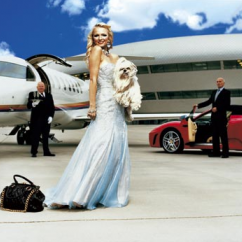Articles and News
LUXURY IN 2012: WHAT TO EXPECT February 16, 2012 (0 comments)

Merrick, NY—Two popular market observers recently released predictions about the luxury market in 2012: Unity Marketing, of Stevens, PA, and the New York City-based Luxury Institute.
Unity’s findings, released last week, are based on its quarterly Luxury Consumption Index, a study that surveys 5,000 consumers per year from among the top 20% of U.S. households. A sample of key trends it sees for the luxury market this year:
- Brands that are adapting to the new luxury market are thriving. The new market includes greater bifurcation between the ultra-luxe and the premium customer, globalization, new shopping patterns, and a wary eye kept on potential class “warfare.” (i.e. the Occupy movement and similar sentiment)
- As the middle class gets weaker, the affluent are becoming more important to everybody, not just luxury brands. Better mass brands like L’Oreal, Ann Taylor/Ann Taylor Loft, JC Penney, Amazon.com, Banana Republic, Anthropologie, and others are getting substantial sales from luxury-leaning affluent consumers.
- Among luxury consumers’ preferred jewelry brands, Danziger says her fourth-quarter survey found Danish beadmaker Pandora ranked in the number-two slot, second only to Tiffany among luxury jewelry brands. She calls the firm a “game-changing competitor,” and expressed surprise that other jewelry designers didn’t consider it to be serious competition. (Editor’s note: Respondents to Unity Marketing’s survey are unlikely to be aware of Pandora’s recent woes; also a few jewelers The Centurionspoke to at the 2012 Centurion show are beginning to see a slowdown in bead sales and question what the brand will do to remain relevant if the trend fades.)
- Affluent incomes that are dependent upon investments, bonuses, and commissions will fluctuate, and those consumers’ spending habits also fluctuate. But the group Danziger has dubbed the HENRYs (high earners, not rich yet) have remained stable in their spending habits.
- The economy is improving but many affluent consumers still watch their spending. While the numbers of those who say they’ve scaled back are much lower than they were in 2008, there’s still a percentage of consumers who have cut back on dining out, who shop less frequently, do more product research and/or comparison shop before buying, started or increased their use of coupons, and who stick to a pre-set list.
- Buying behavior in the luxury market is shifting to inconspicuous consumption, but certain categories of luxury are still up, and jewelry is among them. The biggest gainers in Unity’s survey are in the fashion and home sectors, but watches and jewelry both made positive showings—a 4.9% and 1.6% increase from early 2011 to late 2011. Food, wine, and beauty services were the losers in the index, as consumers trade down to less expensive brands, she says.
Separately, the New York City-based Luxury Institute, headed by Milton Pedrazza, says rising consumer confidence and a steady flow of data confirming an accelerating economy helped drive strong sales gains for luxury goods in January. The luxury market continues to outperform mass retail, Pedrazza says. Positive signs include the wealth effect driving sales—a 20% advance in the stock market since October is making portfolios look much better—plus evidence that home prices have bottomed out and a decline in the unemployment rate again in January.
The Luxury Insitute’s Wealth Report this month says both Saks and Nordstrom’s January year over year sales exceeded forecasts, and Neiman Marcus also reported a substantive gain. Brands such as Coach and Ralph Lauren also posted gains, especially in online for Lauren.
Pedrazza and Danziger differ in their views of the potential impact of the European debt crisis. Danziger believes it may impact investors who hold stock in European companies; Pedrazza says that while the crisis certainly sapped confidence on the continent, most global luxury houses were able to offset soft European sales with rising sales in China and robust U.S. sales. Richemont, for example, enjoyed a 24% boost thanks to strong demand for its watches in the United States and Asia, the Luxury Institute report says.
Top photo: Forbes







